When the first couple of lightweight gaming mice hit the market and saw success there were a lot of brands that tried to cash in on the hype by quickly releasing their own lightweight mice. At a certain point, so many new brands popped up that it became almost impossible to see the forest for the trees, which might explain why we missed the launch of the Pulsar Xlite Wireless. Pulsar is a relatively new brand but their products have been making waves in enthusiast circles, and particularly their Xlite Wireless gets mentioned very often as being a fantastic option for people who desire a lightweight ergonomic wireless mouse, doubly so because it’s sold at an (for a wireless gaming mouse) extremely friendly price point.
We never reviewed the first Xlite Wireless, but when Xlite announced that they would be improving on that well-liked product in the form of the V2 we were all ears, and we sent a unit over to our reviewer to see what he made of it. It the Pulsar Xlite V2 Wireless everything you need if you want a very lightweight wireless gaming mouse, or should you be extra careful before buying? Read our full Pulsar Xlite V2 Wireless review in order to find out everything that you want to know!
Update 1st of July 2022: we have also reviewed the Mini version in case you’re interested in that.
At A Glance
Pulsar Xlite V2 Wireless
Used by 4 players ()There are almost no big objective downsides to the Pulsar Xlite V2 Wireless: it’s a sturdy mouse with an impressively low weight, a flawless sensor, faultless wireless connection, a nice set of main clicks, and a nice finish. The side buttons feel a bit mushy and below par (especially when compared to the rest of the mouse) and the coating can be a touch slippery for dry hands, but other than that this mouse absolutely deserves its cult following.
Pros
- Good build quality
- Flawless gaming and wireless performance
- Good clicks
- Great performance for the price
Cons
- Coating could be grippier
- Not everyone will like the holes in the shell
- Side buttons are a tad mushy
Specs
| Sensor | PMW 3370 |
|---|---|
| Polling Rate | 125 / 250 / 500 / 1000 Hz |
| Button Switches | Kailh GM 8.0 |
| Button Force | 71.4g |
| Connection | Wireless |
| Shape | Ergonomic |
| Length | 12.24cm |
| Height | 4.26cm |
| Weight | 59g |
| Width | 5.92cm |
First Impressions
Since this is my first ever experience with Pulsar as a brand I didn’t really know what to expect. I of course knew that the first Xlite Wireless was/is sort of a cult hit among mouse fanatics, but I hadn’t had the pleasure of holding one of their products for myself, so I was pleasantly surprised when I unboxed the package I got from the mailman.
The Pulsar Xlite V2 Wireless (I’ll refer to it as ‘Xlite V2’ throughout the review) does not feel like a mouse from a brand that’s only just starting out. Everything from the packaging to the mouse itself looks and feels as if it’s made by a company that has a lot more experience under their belt. One of the most immediately notable changes between the V1 and the V2 is that the holes on the side have now been removed. A lot of people strongly dislike the feeling of having their grip fingers come into contact with holes, so it’s definitely a good move by Pulsar to remove the holes in those areas if you ask me.
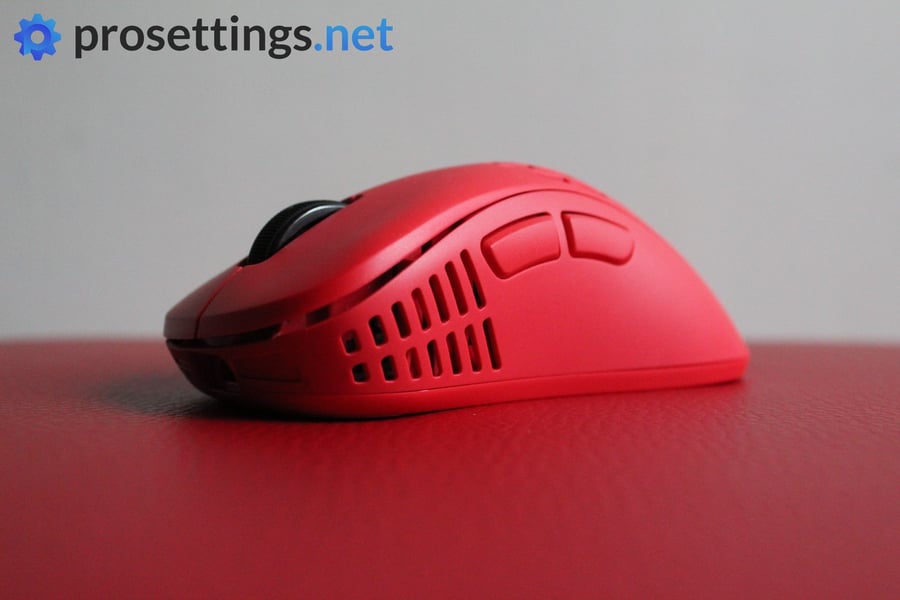
Speaking of holes: you don’t see the traditional hexagonal holes here; instead there are thin strips that have been cut from the shell. It’s a clever move if you ask me, because it differentiates the Xlite from the myriad of other lightweight mice out there: you see these lines and you can be reasonably certain that you’re looking at a Pulsar mouse.
Another aspect that’s quite unique to the Pulsar mice is the bottom. You quite often see honeycomb bottom plates on mice, but here there are entire sections of the bottom plate that have been cut off. You might think that this makes for one heck of a frail pointer device, but that’s not the case at all. I’ll talk more about the build quality further on in the review but the Xlite V2 is all good on that front.
The mouse that I got for review has a red finish but you can also get the mouse in black, white, and a bunch of special edition finishes.
Packaging
Inside the box of the Pulsar Xlite V2 Wireless you’ll find the mouse itself, along with a flexible charging cable that’s finished in a matching color (a nice touch if you ask me), a receiver, and an extension piece that allows you to put the receiver dongle closer to your mousepad. You’ll also find a Pulsar sticker and the regular quickstart information paperwork.
I’d like to see replacement mouse feet included in the package, but at this price point I’m not really complaining.
Shape, Coating, and Mouse Feet
The Xlite V2 Wireless is without a doubt based on the much-copied and very loved Zowie EC shape. This one is slightly larger than the EC2, but a bit smaller than the EC1. Aside from the size difference I don’t find any real differences between the shapes though. This is unmistakably an ergonomic mouse, but its curves feel very natural and gradual and as such it doesn’t force you to hold the mouse in a certain way. This is one of the most copied mouse shapes in the world for a reason: it’s just that good. This type of shape has always been one of my favorites and a sort of ‘comfort shape’ for me (and many others) so if you’re into ergonomic mice then the Xlite V2 is very likely to suit you, or at least not offend you when you’re grabbing it.
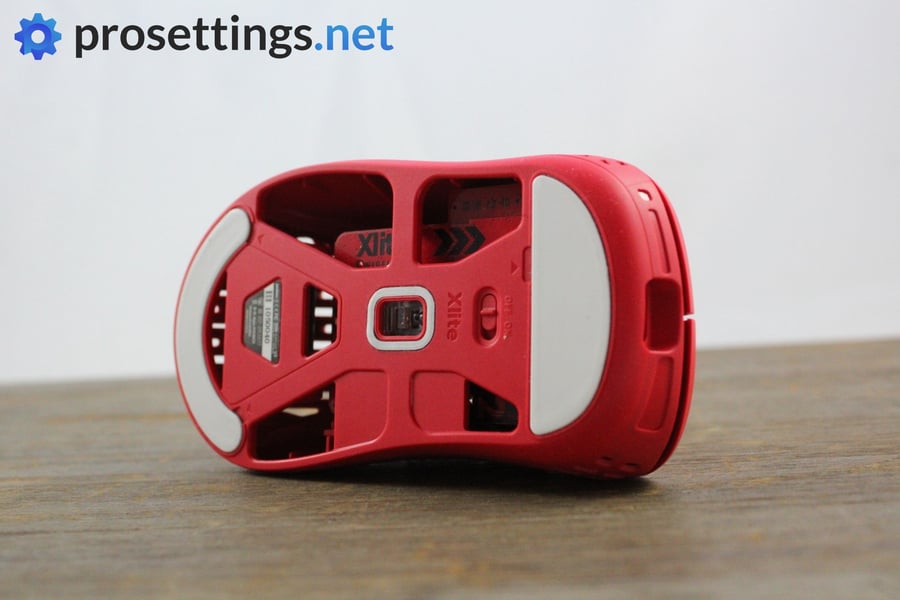
The Xlite Wireless has a matte coating that’s quite resistant to fingerprints and oils. Even after some very intense gaming sessions the shell still felt clean to me, which is definitely a plus. It can feel a touch slippery if your hands are really dry, though, so that’s something to note if your hands are on the drier side. My hands tend to get a bit clammy when gaming so I never had any issues with the grip.
As I said before, Pulsar have removed the holes on the sides because a lot of people complained about the feeling of having holes underneath their fingers, but I’m not sure that they completely succeeded here. With the way I grip this mouse (18×10.5 cm hands with a claw-dominant grip) I still rest my ring finger on the holes on the right side of the mouse. This doesn’t annoy me personally (I find these thin holes to be even less noticeable than the more common hexagonal holes, and I usually don’t even have a problem with those) but if you’re someone who got annoyed by the holes on the original version it might be worth it to check how far up the mouse your fingers are before proceeding to click that ‘add to basket’ button.
Pulsar’s glass Superglide skates have been gaining a lot of traction in the mouse world, but the Xlite V2 ships with default PTFE feet. These aren’t the fastest PTFE skates in the world but they feel very decent to me and I didn’t have any issues with them scratching the mousepads I’ve tested this mouse on. I am someone who likes a steadier, more controlling glide over a super slick and speedy gliding experience so if you ask me these are perfectly fine.
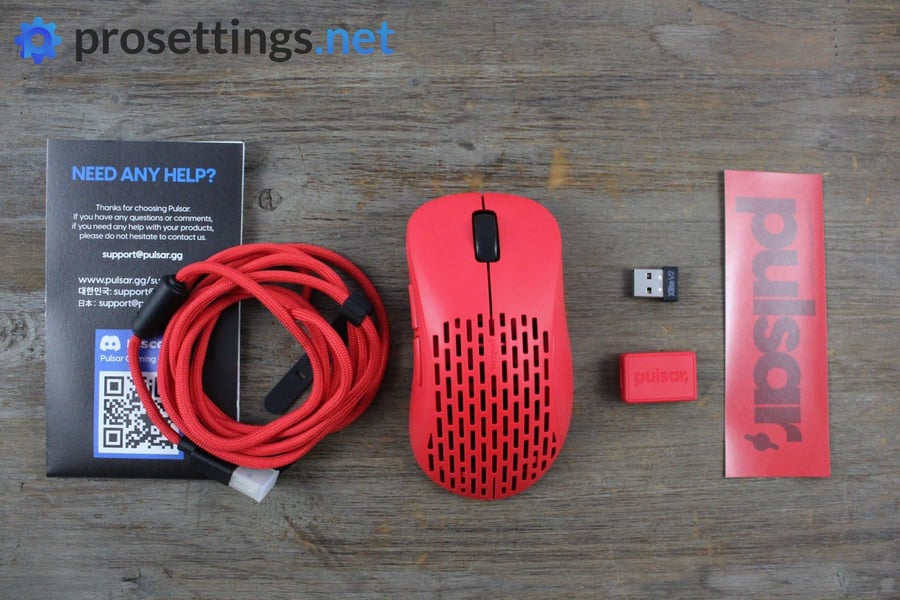
If you do want a fast glide you can always order Pulsar’s Superglides (some special editions of this mouse come with the Superglides pre-equipped) however. I got to try these out as well and they’re definitely slick. Every little micro-maneuver that you make with your hand gets picked up by the sensor if you equip the Superglides, and I even noticed the mouse move with my breath a bit when I firmly held it and took deep breaths. The Superglides are not for me personally, but they’re a cool addition to the mouse market, and if you’ve got a need for speed you should really check them out since they’re available for so many mice right now.
Recommended Grip Types
The shape of the Xlite V2 can accommodate pretty much any grip style if you’re asking me. It’s of course not ideal for pure fingertip grippers (I would usually recommend a symmetrical mouse to those people) but the buttons remain easy to press almost right up until the holes on the top shell start to appear, so even fingertip grippers can get away with using this mouse. It can work perfectly as a palm grip mouse for small to medium sized hands (and also large hands if you prefer smaller mice) and as a claw grip mouse for pretty much all hand sizes if you ask me.
As usual, though, I would like to end this section with a disclaimer: everyone is different, and everyone’s preferences are different. You might be a fingertip gripper who absolutely loves this shape, while there are no doubt going to be claw grippers who strongly dislike this shape. Always do your own research when it comes to mouse shapes, and don’t just buy a mouse because a reviewer or someone online says it’s perfect for grip style X or hand size Y: that’s mostly down to preference and only you can know your own preference on that front.
Buttons and Scroll Wheel
Kailh GM 8.0 switches have rapidly become a community favorite, and as such they can be found in more and more mice these days. I myself am not as wild about these switches as some others are but I do get the appeal: they’re crispy, reliable, last forever, and they offer a nicely tactile and reassuringly loud actuation. As someone who dislikes very light clicks I much prefer this ‘trend’ of going for slightly sturdier switches like the Kailh GM 8.0 over the chase for the lightest possible clicks that took place some years ago, so for me the GM 8.0s are definitely a good choice for a mouse that’s aimed at competitive shooter gamers.
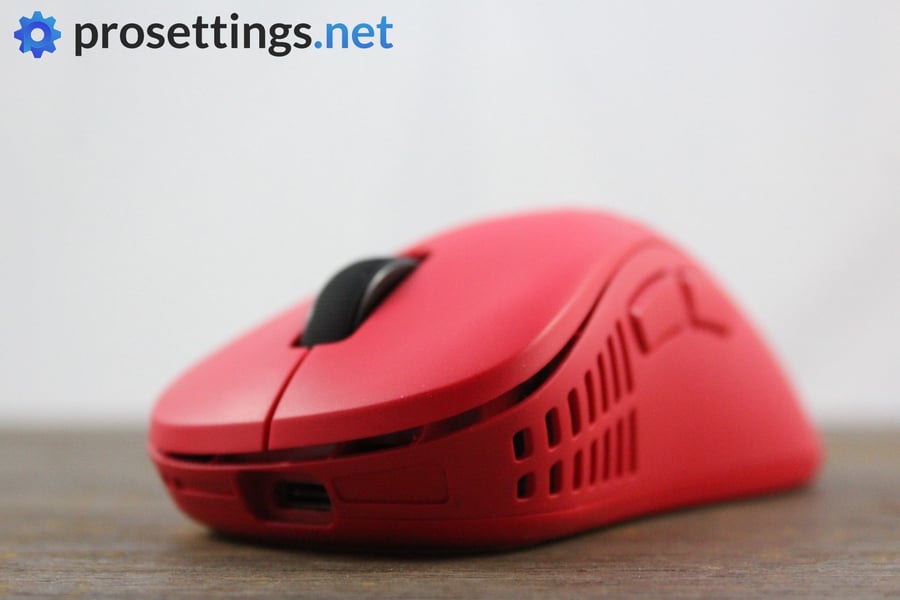
On my copy there’s pretty much no pre travel but there is definitely some post travel present. On the left button it isn’t noticeable in day-to-day usage but on the right button it can be felt ingame if you tend to put your finger closer to the scroll wheel rather than away from it. It never got to a point of annoyance for me personally, but it is something they could possibly tighten up a bit in future releases. There’s no side travel present so all in all these main clicks feel great.
The side buttons are a different story. They don’t use Kailh switches but rather some cheaper switches that feel rather mushy and cheap. Luckily there’s almost no pre- or post travel to be found on the side buttons so they aren’t a total loss but it would be nice to see Pulsar go for some more qualitative switches in the future. Not for performance’s sake: the buttons are implemented nicely and work perfectly fine, it’s just that the switches feel subpar.
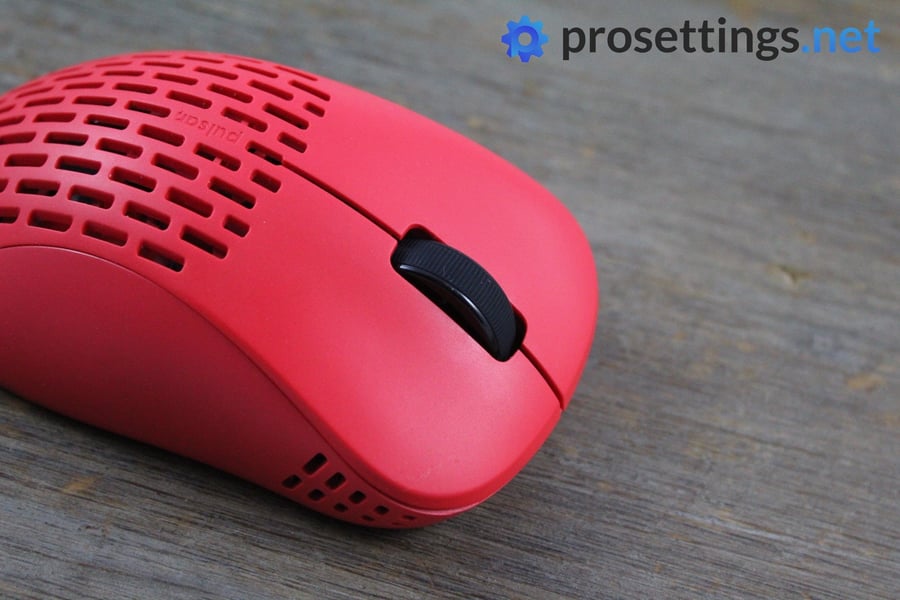
The scroll wheel, then, has been moved up a bit when compared to the first version. I can’t make any direct comparisons since I haven’t used the Xlite V1 but I can say that I don’t have any issues with the wheel on this second version. It’s slightly textured and it’s raised just enough so that reaching and using it in the heat of battle is no problem at all. The steps are rather subtle (and almost completely silent) so if you’re looking for a loud and proud wheel with lots of tactility this ain’t it but for me this feels okay. If the steps were just a bit less pronounced I think they would’ve been too light for me personally though, so I hope they don’t go any lighter in future revisions. The wheel is rather easy to press but if you ask me it could’ve been a bit lighter on that front. I didn’t suffer from any accidental scrolls or wheel clicks during my testing so it all performs fine: I’m just talking about the finer details here.
Build Quality and Cable
Lightweight mice historically haven’t always been the most solidly built ones, but the Pulsar Xlite V2 Wireless definitely feels great on that front. You can hear the scroll wheel move around a tiny bit when you pick the mouse up and give it a good shake but that’s something that never happens when you’re using it normally so that’s not an issue at all. There’s also no shell flex, nor is there any creaking on the top or side portions of the mouse. The bottom plate is a little less structurally sound as you can get it to flex a little if you put enough pressure on certain parts, but that will absolutely never be an issue since the bottom plate isn’t gonna be subjected to very localized and forceful presses when using the mouse normally. All in all the build quality of the Xlite V2 is absolutely stellar for a mouse that’s this light.
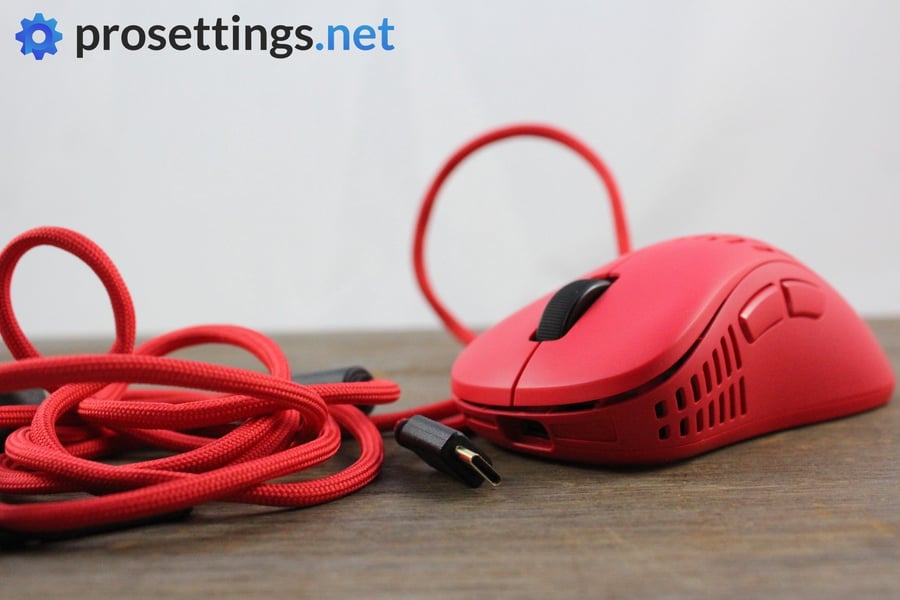
The cable, should you have to use it while playing, is thin and flexible and you can use it for gaming without any issues whatsoever, but ideally that’s not something you’d be doing very often since you’ll obviously want to take full advantage of the fact that this is a wireless mouse. A cool touch is that the cable matches the mouse’s color. It doesn’t do anything for the performance but it makes the whole package look a bit more premium if you’re asking me, and attention to detail should also be applauded in products.
Sensor and Everyday Performance
The Xlite V2 Wireless houses a flawless 3370 sensor. That’s one of the industry leaders when it comes to sensors in wireless gaming mice for a reason, and Pulsar have implemented it nicely. I saw no signs of sensor malfunction during my testing and the wireless performance it stellar as long as you have the receiver dongle close enough. I say this because I noticed some instances of the mouse being a bit slow to wake up after a short period of inactivity if I had the dongle plugged in a bit far from the pad that the mouse was sitting on. Once I got the mouse moving I had absolutely no issues, but I would strongly advise you to use the included extender to place the receiver as close to your mousepad as possible just to be sure.
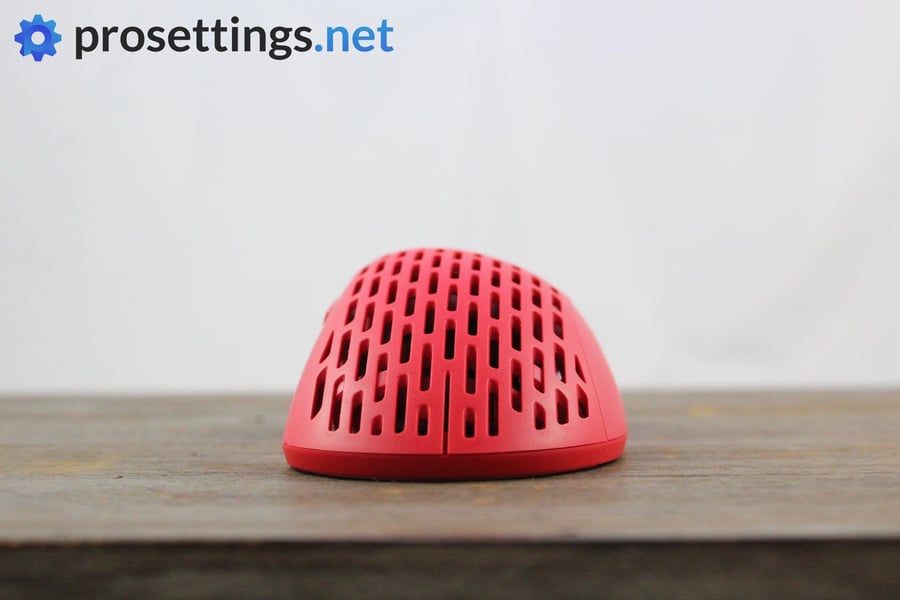
Pulsar also offers optional software, even though you can use the mouse in a plug-and-play capacity should you want to, provided you don’t play at uncommon DPI levels of course. If you do use an uncommon DPI, or you’re someone who likes rebinding buttons or creating macros and the likes you can download Pulsar’s nameless software in order to do just that. It’s certainly not the most expansive piece of kit, nor is it the flashiest looking, but it all works and it’s easy to use. All in all this is a very lightweight piece of optional software, and that’s the way it should be if you ask me.
Something that’s also changed between the V1 and V2 versions is that the battery has been moved to the back to allow for a better weight balance. I sadly can’t compare the two but the V2 feels nicely balanced. If you pick it up with two fingers in the geometrical middle it is perhaps a bit off-center but you never do that in game anyway. I certainly never felt the mouse keel over when doing swipe resets and I do those quite often since I’m a low sens player. For me, the weight balance is pretty much spot on.
Pulsar Xlite V2 Wireless Review – Conclusion
After seeing so many people sing the Xlite V1’s praises online I was expecting the V2 to be a fantastic mouse, and it absolutely delivered. There are almost no big objective downsides to the Pulsar Xlite V2 Wireless: it’s a sturdy mouse with an impressively low weight, a flawless sensor, faultless wireless connection, a nice set of main clicks, and a nice finish. The side buttons feel a bit mushy and below par (especially when compared to the rest of the mouse) and the coating can be a touch slippery for dry hands, but other than that this mouse absolutely deserves its cult following. It delivers great performance and specs at a very impressive price point. You should definitely put this one on your list (and put it near the top) if you’re looking for an ergonomic mouse.
This product was received for free from the manufacturer and given to our reviewer to test and review. Brands and manufacturers have no editorial control over our reviews. For more information, check out our review FAQ.


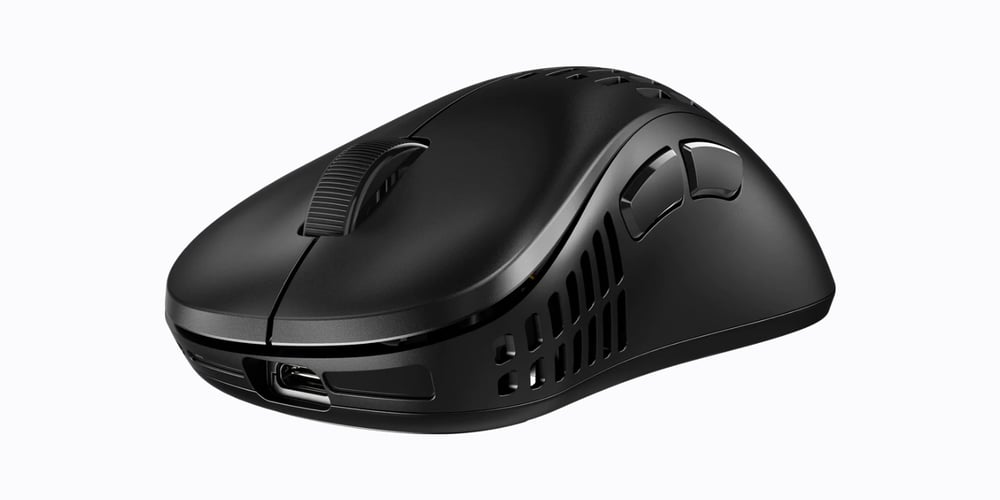




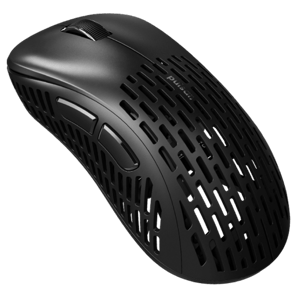


Lars,
I don’t see this mouse on the list of mice pros are using. So, wondering if these mice are good enough for competitive esports ? Maybe the pros have to officially use/state the mice they’re using for sponsorship reasons ?
This is an older mouse at this point, so it’s logical that it’s not being used so much since it’s A) an older model and B) from a smaller brand.
Pulsar mice are actively being used in the pro scene though (it’s among the 10 most used brands at this point in time) so there’s absolutely nothing wrong with their products from a performance POV.
If you want to learn more about sponsorships in esports, you can always read our article on the subject: https://prosettings.net/blog/about-sponsorships-in-esports/
hello, I have a 17.5cm hand and I wonder if it will not be too small and I do not want the normal version because it is too big, I currently have the EC2-b
It feels quite a lot smaller than the EC2 to me personally, so if that size is just about right for you I would go for the normal version. If you want a smaller version then the V2 Mini could be a good bet. Basically it depends: do you want a mouse that’s (a lot) smaller than the EC2 in the hand -> V2 Mini. Want a mouse that’s almost similar as the EC2 -> Regular V2. That’s how I see it at least!
Thanks for answer, there is a dimension error on your article, the mouse is 11.7 cm in length and not 11.21 cm
The ec3-c exist my guy it’s basically just a shorter ec2-c